
Kuala Lumpur Sentral Station is a transit-oriented development that houses the main railway station of Kuala Lumpur, the capital of Malaysia. Opened on 16 April 2001, KL Sentral replaced the old Kuala Lumpur railway station as the city's main intercity railway station. KL Sentral is the largest railway station in Malaysia, and the second largest in Southeast Asia, behind Krung Thep Aphiwat Central Terminal in Bangkok, Thailand.

The Kuala Lumpur Tower, colloquially referred to as KL Tower, is a 6-storey, 421-metre-tall telecommunication tower in Kuala Lumpur, Malaysia. It is the world's 39th tallest tower and seventh-tallest telecommunication tower. It features an antenna which increases its height to 421 metres. The roof of the pod is at 335 metres. The rest of the tower below has a stairwell and an elevator to reach the upper area, which also contains a revolving restaurant, providing diners with a panoramic view of the city.
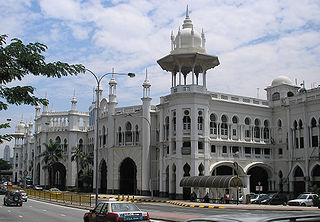
The Kuala Lumpur railway station is a railway station located in Kuala Lumpur, Malaysia. Construction began in 1910 and was fully completed in 1917. It replaced an older station on the same site, the station was Kuala Lumpur's railway hub in the city for the Federated Malay States Railways and its successor Keretapi Tanah Melayu, before Kuala Lumpur Sentral assumed much of its role in 2001. The station is notable for its architecture, adopting a mixture of Eastern and Western designs.

Berjaya Times Square is a 48-storey, 203 m (666 ft) twin tower, hotel, condominium, indoor amusement park and shopping centre complex in Bukit Bintang, Kuala Lumpur, Malaysia. It was opened in October 2003 by the 4th Prime Minister of Malaysia, Tun Dr Mahathir bin Mohamad.
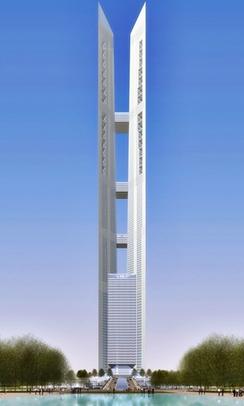
The 102 Incheon Tower was a supertall twin tower proposed for construction in Songdo International City, Incheon, South Korea. The design consisted of two 151 floor, 613 m (2,011 ft) supertall skyscrapers connected by three skybridges. The building would have become the tallest twin towers in the world, surpassing the Petronas Towers in Kuala Lumpur, Malaysia, and one of the tallest buildings in Asia. After the late-2000s recession, the tower was postponed with the possibility of a redesign at a lower height. The height of the tower was reduced from 613 metres to 487 metres while keeping the design the same.
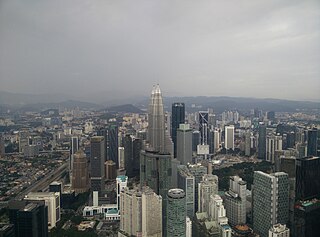
Kuala Lumpur City Centre (KLCC) is a multipurpose development area in Kuala Lumpur, Malaysia. KLCC refers to the area within and surrounding the KLCC Park but the term has also been widely used by buildings nearby to the vicinity.

The Pasar Seni station is an integrated rapid transit station in Kuala Lumpur that is served by the Kelana Jaya Line KJL and the Kajang Line KGL . The station is named after the nearby Central Market and is located near Petaling Street and the area known as the Chinatown of Kuala Lumpur.
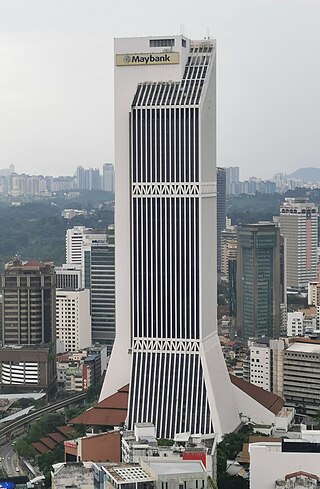
Maybank Tower is a skyscraper in Pudu, Kuala Lumpur, Malaysia. The tower serves as the headquarters of Maybank and houses the Maybank Numismatic Museum.
The architecture of Kuala Lumpur is a blend of old colonial influences, Asian traditions, Malay Islamic inspirations, modern and post modern mix. Being a relatively young city, most of Kuala Lumpur's colonial buildings were built toward the end of 19th and early 20th century. These buildings have Mughal, Tudor, Neo-Gothic or Grecian-Spanish style or architecture. Most of the styling have been modified to cater to use local resources and the acclimatized to the local climate, which is hot and humid all year around.

Capital Square, commonly referred to as Cap Square, is a residential condominium skyscraper and shopping mall along Jalan Munshi Abdullah, in midtown in Kuala Lumpur, Malaysia, developed by Bandar Raya Developments Berhad. Apart from retail spaces, the development encompasses one 36-storey condominium block and one office block under phase 2. Phase 1, which comprised a single 40-storey office block, Menara Multi Purpose, was completed back in 1994. Menara Multi-Purpose is also home to Bandar Raya Developments Berhad's corporate headquarters. The completed 36-storey residence component of the Cap Square development comprises 180 apartment units.

Quill City, formerly Vision City and known as Bandar Wawasan in the Malay language, is a partially completed integrated development project located along Jalan Sultan Ismail, close to Kampung Baru in Kuala Lumpur, Malaysia.
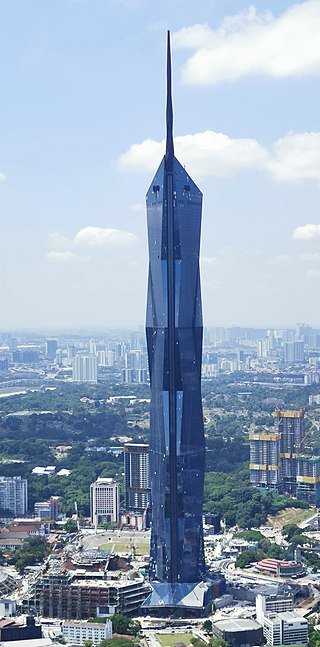
Merdeka 118, formerly known as Menara Warisan Merdeka, KL 118 and PNB 118, is a 118-story megatall skyscraper in Kuala Lumpur, Malaysia. At 678.9 m (2,227 ft) tall, it is the second-tallest building and structure in the world, only behind the Burj Khalifa at 828 m (2,717 ft).
Kington Loo was an architect in Malaysia who belongs to the group who brought modernism to Southeast Asia in the wake of World War II. The firm he worked for, Booty and Edwards, became a leader in the region. His mother, Lok Soh June, was an accomplished piano player and was the sixth daughter of millionaire businessman Loke Chow Kit; his father, the engineer Yuson Loo, was the grandson of prominent businessman Loke Yew. He was married and had a daughter, Ysa Loo.

Four Seasons Place Kuala Lumpur, also known as Four Seasons KLCC and FSP KLCC Tower, is a 74-story, 342.5-metre tall (1,124 ft) supertall skyscraper in Kuala Lumpur City Centre, Malaysia. It is Malaysia's fourth tallest building. It features a 21 m (69 ft) high crown made out of steel at the top of the tower, making the tower reaches the height of 342.5 m (1,124 ft). It is located within the Kuala Lumpur City Centre precinct in Kuala Lumpur, Malaysia. The building was developed by Ipoh-born Singapore tycoon, Ong Beng Seng, partnering Tan Sri Syed Yusof Tun Syed Nasir and the Sultan of Selangor under Venus Assets Sdn Bhd. It is currently the fourth tallest building in Malaysia.

The Tabung Haji Tower is a 38-storey, 152 m (499 ft) office skyscraper and is the headquarters of Malaysian Hajj Pilgrims Fund Board in Kuala Lumpur, Malaysia. The tower, designed by architect Hijjas Kasturi, was completed in 1984.

Permata Sapura Tower is a skyscraper located at the Kuala Lumpur City Centre (KLCC) in Kuala Lumpur, Malaysia. The skyscraper has a height of 252.5 metres with 53 floors. The construction of the skyscraper was completed in 2020 and is currently among the tallest skyscrapers in Malaysia.
















